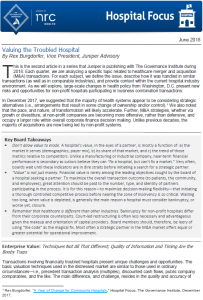Valuing the Troubled Hospital
 Financial difficulties are commonly the catalyst for hospitals to begin exploring partnership options. As Rex Burgdorfer, Juniper Advisory Vice President, outlines in his latest article “Valuing the Troubled Hospital”, court-led restructuring is an option often considered by those with liquidity constraints and significant financial liabilities.
Financial difficulties are commonly the catalyst for hospitals to begin exploring partnership options. As Rex Burgdorfer, Juniper Advisory Vice President, outlines in his latest article “Valuing the Troubled Hospital”, court-led restructuring is an option often considered by those with liquidity constraints and significant financial liabilities.
For hospitals nearing the zone of insolvency, retiring funded debt, unwinding interest rate swaps, satisfying defined benefit pension plans and covering post-closing risks are significant considerations when negotiating terms. Debt-heavy capital structures combined with today’s difficult operating environment has narrowed the margin of error for sellers. This reality places an increased importance on a complete, accurate valuation of a hospital’s assets and liabilities to guide mutually beneficial terms of a business combination.
These considerations should also encourage Boards of struggling non-profit hospitals to begin their partnership exploration process sooner, from a stronger financial position, and not delay until it’s too late to find a partner.
Key Board Takeaways
- Don’t allow value to erode. A hospital’s value, in the eyes of a partner, is mostly a function of: a) the market it serves (demographics, payer mix), b) its share of that market, and c) the trend of those metrics relative to competitors. Unlike a manufacturing or industrial company, near-term financial performance is secondary as suitors believe they can “fix a hospital, but can’t fix a market.” Very often, boards wait until these indicators are in dire straits before initiating a search for a strategic partner.
- “Value” is not just money. Financial value is rarely among the leading objectives sought by the board of a hospital seeking a partner. To maximize the overall transaction outcome (to patients, the community, and employees), great attention should be paid to the number, type, and identity of partners participating in the process. It is for this reason—to maximize decision-making flexibility—that initiating a thorough controlled competitive process before nearing the zone of insolvency is so critical. Waiting too long, when value is depleted, is generally the main reason a hospital must consider bankruptcy, or worse yet, closure.
- Remember that healthcare is different than other industries. Bankruptcy for non-profit hospitals differ from their corporate counterparts. Court-led restructuring is often less necessary and advantageous given the makeup and orientation of capital providers. Board members should, therefore, be leery of using “the code” as the magical fix. Most often a strategic partner in the M&A market offers equal or greater potential for operational improvement.